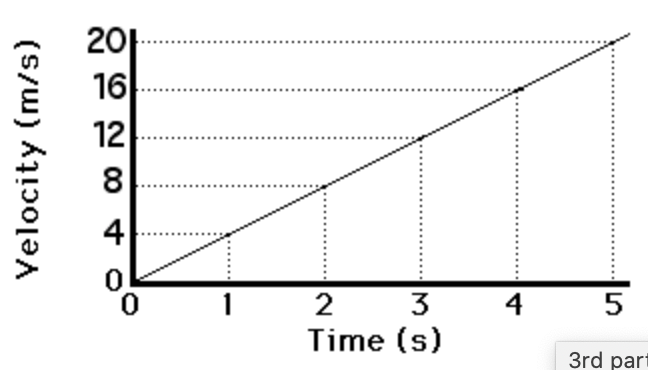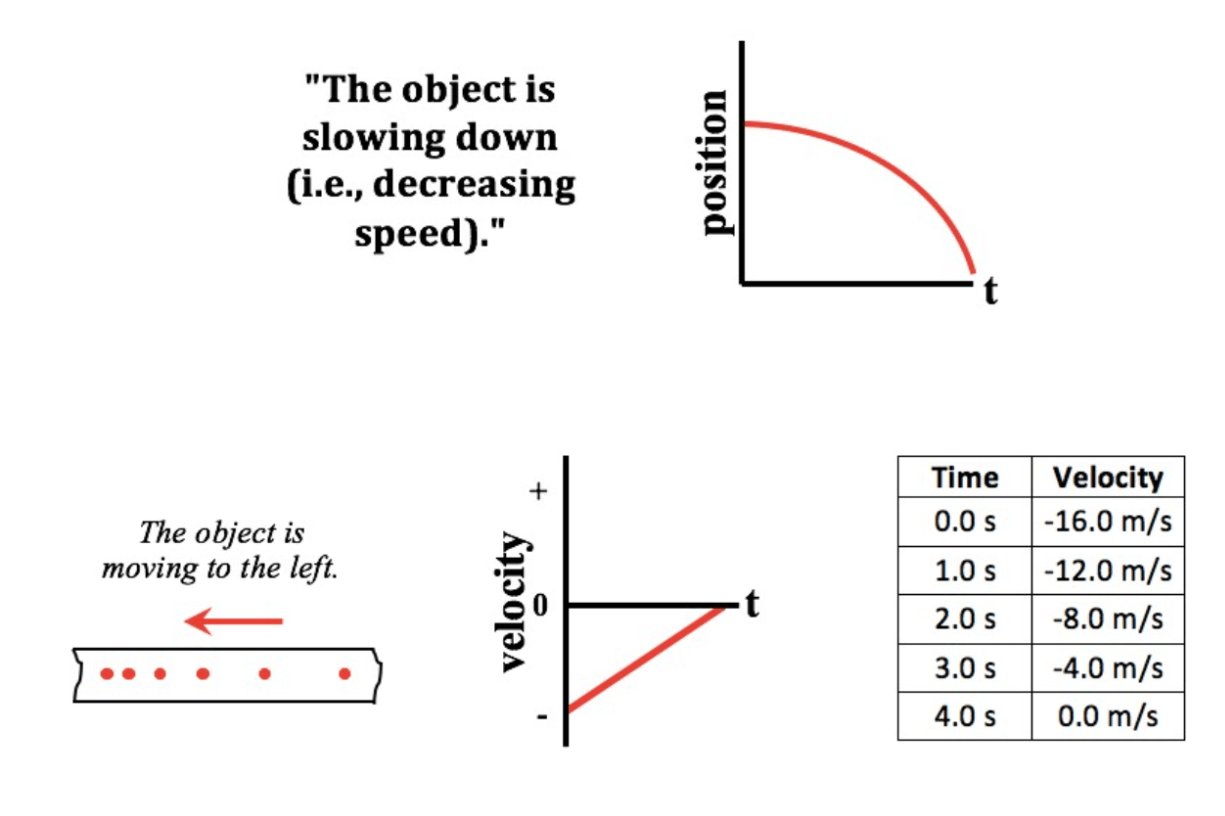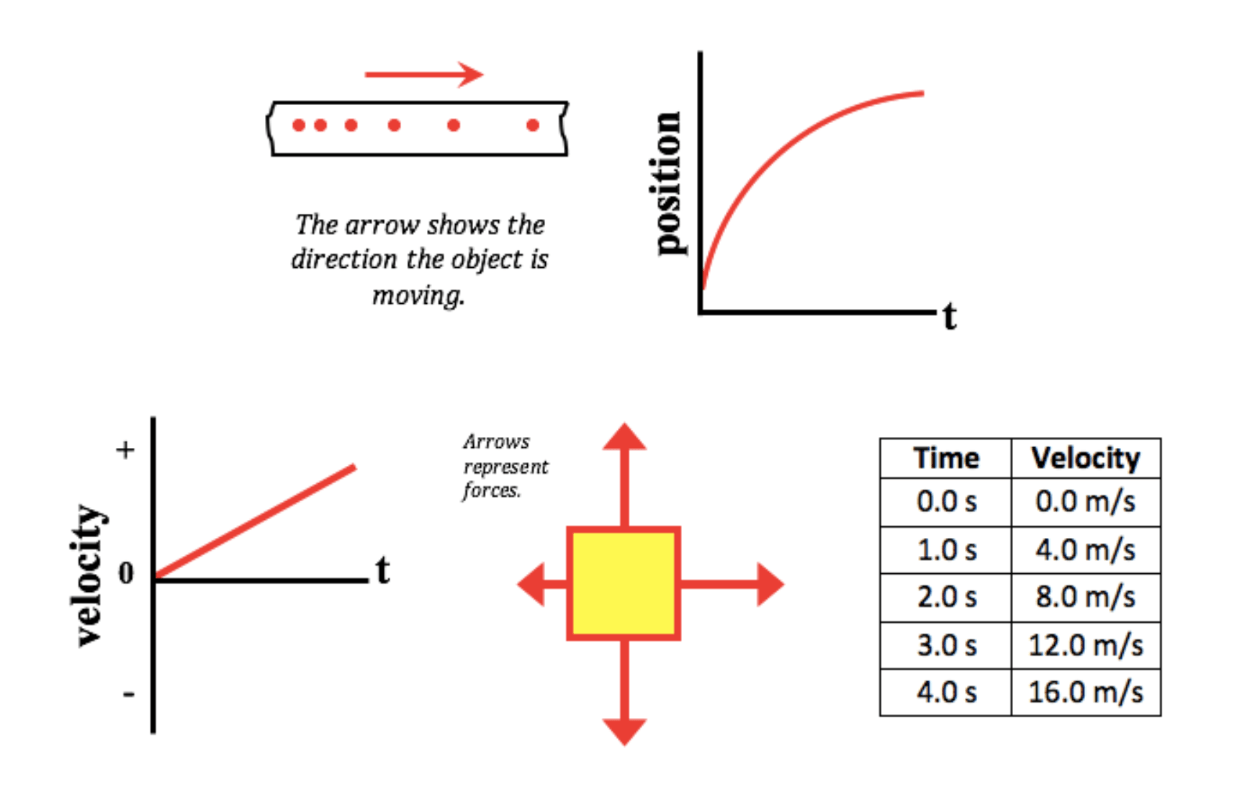a) Explain what the Big Bang theory says the universe was like in the first second.
b) Discuss earth's formation starting with dust particles and including how earth got its water.
a) very hot, very dense, violent, speck of pure energy, expanding rapidly
b) The opposite charges of the dust particles caused them to start coming together and form rocks, gravity caused the smaller rocks to hit each other, melt, and stick to each other, gravity forced the Earth into a spherical shape, Earth’s layers formed by the most dense molten layers heading towards the center and Earth's water was present in the Nebula that formed Earth
A car starts from rest and 15 seconds later it has a final velocity of 100 m/s. What is the car's acceleration?
acceleration = (final velocity - initial velocity) / time
acceleration = (100 m/s - 0 m/s) / 15 s
acceleration = 6.67 m/s/s
1) What happens to an astronauts a) mass and b) weight as she travels from the earth to the moon?
2) On Earth, what is the weight of a man with a mass of 92 kg?
3) What is the mass of a man with a weight of 833N?
1a) The mass is the same but
1b) the weight will decrease because the moon has less gravity.
2) 902N
3) 85 kg
a) How much work is done when a 500 N boy carries a 0.85 N ball across a field for 38 m?
b) How much work is done by a woman when she pushes with 800 N on a 1600 kg car for 15 m?
a) 0 Joules because the Force is up and the direction of travel is forward.
b) Work = Force x Distance
Work = 800 N x 15 m
Work = 12,000 Joules
a) Where is a proton located and what is its charge?
b) Where is a neutron located and what is its charge?
c) Where is an electron located and what is its charge?
a) Protons are located in the nucleus and haave a positive charge
b) Neutrons are located in the nucleus and have no charge (neutral).
c) Electrons are in orbit around the nucleus and have a negative charge.
What does Hubble’s Law state about galaxies in relationship to the earth?
All galaxies are moving away from the Earth but galaxies that are farther away are moving away faster.
What is the acceleration of the object represented in the graph of velocity depends on time?

acceleration = (final velocity - initial velocity) / time
acceleration = ( 20 m/s - 0 m/s) / 5 s
acceleration = 4 m/s/s
Describe Newton's First Law with a) velocity b) forces c) acceleration.
a) velocity is constant or 0 m/s
b)Forces are balanced
c) acc=0 m/s/s
If a 0.55 kg ball is dropped with negligible resistance from 6.3 meters with 34 J of PE, how much KE will it have at the bottom of the cliff?
M.E.i = M.E.f
GPE = KE
34 J = 34 J
a) What does the atomic mass of an element tell you?
b) What does the atomic number of an element tell you?
a) The number of protons and the number of neutrons in that element added together .
b) The number of protons and the number of electrons in that element.
a) List 3 major characteristics of a Black Hole
and
b) explain what happens to something as it is sucked into them..
a) Black Holes are very strong (gravity) and they suck in anything that gets close to them, they cannot be seen directly, and their centers are called singularities but are not well understood
b) Gravity is huge so the acceleration and weight of the object will be huge and the part of the object closest to the black hole will be stretched more Spaghettification)
A jet lands on the runway with a velocity of 78 m/s and 20 seconds later comes to a rest. What is the acceleration of the jet?
acceleration = (final velocity - initial velocity) / time
acceleration = ( 0 m/s - 78 m/s) / 20 s
acceleration = - 3.9 m/s/s
Describe Newton's Second Law with a) velocity b) forces c) acceleration.
a) velocity is changing
b)Forces are not balanced
c) acc is not 0 m/s/s
What is the momentum of a 400 kg boulder rolling at 13 m/s?
p = mv
p = 400 kg x 13 m/s
p = 5200 kgm/s

a) What is the atomic number of Tantalum?
b) What is the atomic mass of Tantalum?
c) How many protons are in the nucleus?
d) How many neutrons are in the nucleus?
e) How many electrons are in one atom of this element?
a) 73
b) 181
c) 73
d) 108
e) 73
a) List four characteristics of Main Sequence stars.
b) List the stages of life for our Sun, a low mass Main Sequence star.
a) Fusion is taking place, hydrogen is burning to make helium and a large amount of energy is being produced. Their next phase depends on their mass.
b) Gas/Nebula, Protostar, Main Sequence, Red Giant, Planetary Nebula, White Dwarf
Which one doesn't belong?
Position depends on Time graph doesn't belong.
Explain what an acceleration of 21 m/s/s means.
The speed increases 21 m/s every second.
A 0.53 kg toy truck rolls down a 2.83 m long frictionless ramp from a height of 0.88 m.
a) What is the gravitational potential energy of the truck at the top of the ramp?
b) What is the kinetic energy of the truck at the bottom of the ramp? Why?
a) GPE = mass x g x height
GPE = 0.53 kg x 9.8 m/s/s x 0.88m
GPE = 4.57 J
b) 4.57 J There was not any friction so all of the PE turned into Ke.
Balance this equation:
Al2O3 ------> Al + O2
2 Al2O3 ------> 4 Al + 3 O2
What may happen to high mass later stage red supergiant stars?
They fuse elements from hydrogen all of the way up to iron, as fusion slows the pressure decreases and the star collapses creating a supernova explosion that ejects elements into space leaving a core that may become a neutron star or a black hole.
Which one doesn't belong?
Position depends on Time graph doesn't belong.
A 5000 N piano is lifted by a crane with a chain with a force of 6500N.
a) Calculate the net force (unbalanced force) ON THE PIANO.
b) Calculate the mass of the piano.
C) Calculate the piano’s acceleration.
a) Fnet = Sum of all forces in one dimension
Fnet = Tension - Weight
Fnet = 6500 N - 5000 N
Fnet = 1500 N
b). weight = mass x g
mass = weight / g
mass = 5000 N / 9.8 m/s/s
mass = 510 kg
c). Fnet = mass x acc
acc = Fnet / mass
acc = 1500 N / 510 kg
acc = 2.94 m/s/s
a) What is the kinetic energy of a 45 kg dog running at 2.5 m/s?
b) An 18 kg child skips with 3.46 J of KE, what is her velocity?
a) KE = 1/2 mass x velocity2
KE = 1/2 (45kg)(2.5m/s)2
KE = 141 J
b) KE = 1/2 mass x velocity2
v = sqrt((2*141)/45)
0.62 m/s
Balance this equation:
C2H6 + O2 ------> CO2 + H2O
2C2H6 + 7O2 ------> 4CO2 + 6 H2O